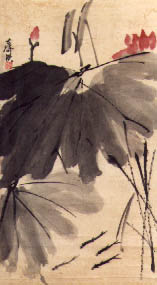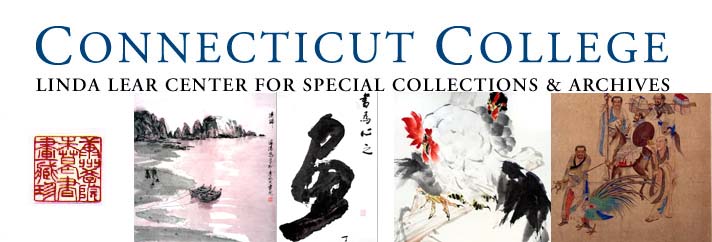Flowers, Insects, and Bird Paintings
Ch'i Pai-shih (1863-1957)
Lotus
Hanging Scroll, Ink and Color on Rice Paper, 38.5 x 21 in., (98 x 53 cm.)
 Ch'i Pai-shih has been known as the Picasso of China. This is one of the two paintings of his we have in our collection. Simple composition, economy of brush strokes and often bold contrasts in color make his style unique and easily recognizable.
Ch'i Pai-shih has been known as the Picasso of China. This is one of the two paintings of his we have in our collection. Simple composition, economy of brush strokes and often bold contrasts in color make his style unique and easily recognizable.
His fame did not come easily. Early in life he had only four months of elementary education, and worked as a carpenter for fifteen years. He learned to paint in order to decorate woodwork he had created, thus discovering that he enjoyed the artistic and decorative work more than building furniture. He decided to switch to art.
First he learned to paint insects and grasshoppers in a detailed manner. Then he travelled within China concentrating on landscape painting. During these travelling years (1902-1907) the sale of his paintings did not make him rich. In 1917 it was the sale of his carved seals that kept him from poverty. As his painting skills progressed, his fellow artists, recognizing his natural talent, encouraged him to develop his own painting styles. In 1919 Ch'i Pai-shih moved to Peking and began to concentrate on birds, flowers, fish, shrimp, crabs and many other objects. Simplicity characterized his paintings. He aspired to minimize strokes to capture the spirit of his subjects. This is where his strength lies, and that is how the world recognizes him. Prices for genuine works by Ch'i Pai-shih continue to soar.
In 1949 the People's Republic of China recognized him as a national asset, naming him a "People's Artist." His ten thousand original paintings are in great demand. Our painting of Lotus blossoms was given to the collection by the family of Liz Lee Lewandrowski, a Connecticut College alumna, class of 1982. It was a family treasure of the Lee's until the parents of Liz kindly and generously donated it to the Chu-Griffis Collection.
